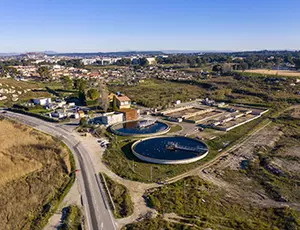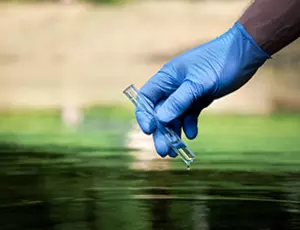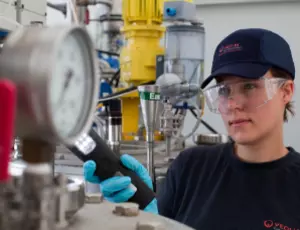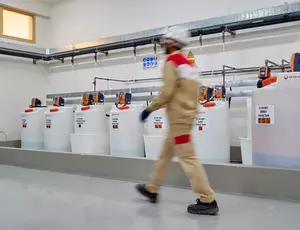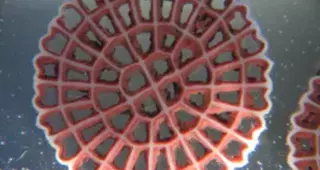eXeno™ is a moving bed biofilm reactor (MBBR) technology used for the biological treatment of micropollutants, such as pharmaceuticals.
Overview
eXeno is an MBBR technology from AnoxKaldnes® — a subsidiary of Veolia Water Technologies — that can be used for the biological treatment of micropollutants, such as drugs, personal care products and industrial chemical compounds in wastewater.
The MBBR relies on natural microorganisms growing as biofilms with long retention times in the system, encouraging the development of slow-growing organisms capable of removing difficult-to-degrade compounds.
Even at low concentrations, micropollutants from the pharmaceutical and cosmetics, municipal, mining and chemical processing industries, can be toxic to the environment, aquatic wildlife and ecosystem functioning. They pose risks to domestic water supplies if not properly treated and can spread antibiotic-resistant genes if a high level of pharmaceutical drugs accumulates over time.
Standard municipal wastewater treatment plants are not designed for the specific removal of micropollutants including pharmaceuticals. Additional treatment is needed, and historically this was achieved using strong chemical oxidizing agents. However, there is a more sustainable way to tackle this challenge.
How it works
eXeno comprises three MBBR reactors in a series. Each MBBR reactor contains a moving bed of microorganisms, growing on thousands of MBBR carriers that create a large protected surface of microorganisms called a biofilm. This biofilm first treats the most easily degradable micropollutants, moving on through to the most difficult.
For the treatment of pharmaceuticals, eXeno typically involves multiple reactors in series where the microorganisms can be specialized to target a wide variety of complex compounds.
The MBBR technology promotes microorganism development and creates biomass with significantly longer sludge retention times compared with conventional systems. This encourages the development of slower-growing microorganisms capable of removing hard-to-degrade micropollutants.
eXeno is suitable for the complete treatment of micropollutants from pharmaceuticals in wastewater to tertiary solutions for municipal wastewater treatment applications.
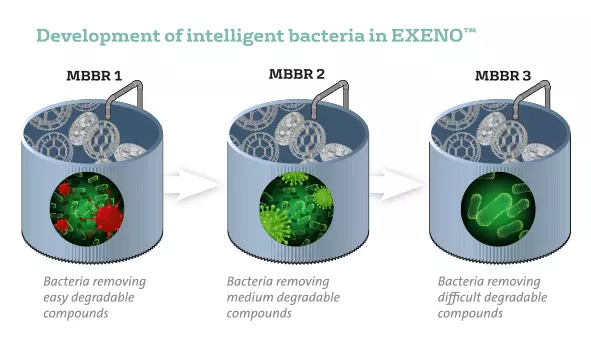
eXeno benefits include

Economic
reduced energy and chemical consumption using optimal microorganisms and less ozone and/or activated carbon.

Environmentally friendly
avoid the release of by-products and the transfer of pollutants from liquid to solids.

Proven
more than 30 years of experience with over 25 references in the pharmaceutical industry and two full-scale references in the municipal market
Applications
Services
We offer customers a range of services including process support contracts, laboratory trials and diagnostic microscopy.
Product range and Resources
eXeno™-M
A newly launched patented solution, to apply biological treatment to the post-treatment of municipal treatment plants for removal of drug residual due in anticipation of upcoming regulations.
eXenO₃
This combines the benefits of MBBR biological treatment of micropollutants with an ozonation pre-treatment step. The MBBR complements ozonation (Ozonia) and also treats transformation products generated by ozonation from the oxidation of micropollutants, which can be toxic.
Contact
Understanding the impact of micropollutants on the environment is crucial. Even at low concentrations, these substances can pose serious health risks and endanger potable water supplies. With eXeno, we employ specialized microorganisms to biologically degrade these pollutants, minimizing the need for chemical addition and ensuring low energy consumption.

Fernando Morgan-Sagastume
Technology strategy manager, Veolia Water Technologies Sweden
Contact Fernando through his LinkedIn account
FAQ about eXeno™
What are micropollutants?
Micropollutants are compounds present in small concentrations (nanograms to micrograms per liter) in municipal wastewater. Micropollutants include pharmaceuticals, personal care products or industrial chemical compounds, also referred to as emerging contaminants that are typically difficult to degrade.
The major sources of micropollutants are:
- Household consumption of medicines, which on leaving our bodies make their way to the local municipal wastewater treatment plant.
- Chemical industries, including the production of pharmaceuticals, cosmetics, biocides and pesticides.
- Hospital discharges, which have high levels of pharmaceuticals from medications and chemotherapy treatments, along with iodinated contrast media introduced to the body during x-rays.
What is a Moving Bed Biofilm Reactor (MBBR)?
An MBBR is a biological wastewater treatment process that uses microorganisms growing in biofilms to degrade and remove pollutants from wastewater. Specialized microorganisms grow on the extensive surface area provided by carriers that are kept in movement in the active volume of the reactor or tank. MBBR is a robust and compact technology.
What makes Moving Bed Biofilm Reactor (MBBR) technologies cost-efficient?
The biofilm carrier elements inside an MBBR enable the growth of microorganisms that results in a biological treatment process, with a much smaller footprint, and greater efficiency than conventional systems, such as activated sludge. This feature also allows for the biodegradation of micropollutants.
The reduced footprint saves space on site and reduces costs for materials, power and civil construction, which all contribute to a lower carbon footprint. Often MBBR systems are retrofitted into existing infrastructure, which also delivers a saving on civil construction work.




